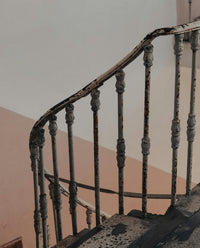Wrought iron is a durable, timeless metal often used for railings, gates, and decorative pieces because of its classic look and strength. But one question that always comes up with wrought iron is: does it rust? Having worked with it for years, I can tell you that it’s a concern worth addressing, especially if you want to keep your ironwork looking great for a long time.
Why Does Wrought Iron Rust?
Rusting is a natural process that occurs when iron reacts with oxygen and moisture, creating a reddish-brown substance known as rust. This happens because iron is highly reactive to oxygen, and when water (even just humidity in the air) is present, it accelerates the process. The iron surface starts breaking down, forming iron oxide, which we see as rust. It’s a common issue that can happen to any unprotected iron surface, but wrought iron—being more porous than other metals—makes it even easier for moisture to penetrate and speed up this reaction.
Environmental Factors That Contribute to Rust Formation
From my experience, one of the biggest factors that cause wrought iron to rust is exposure to moisture—whether it’s rain, humidity, or even saltwater if you live near the coast. Humid environments make wrought iron especially prone to rust because moisture can get trapped in the tiny crevices and pores of the metal. On top of that, airborne pollutants, like sulfur dioxide, can also accelerate the rusting process by forming acids when mixed with water, making the iron deteriorate even faster. So, even the air quality around your home can affect how quickly wrought iron rusts.

Why Wrought Iron Rusts More Easily Than Some Other Metals
Wrought iron rusts more easily than some other metals, like aluminum or stainless steel, because of its unique composition and texture. Unlike stainless steel, which has chromium to create a protective layer, or aluminum that forms a natural oxide barrier, wrought iron doesn’t have these built-in defenses. Having years of experience in the handrail business, I can say with confidence that wrought iron’s rough and porous surface traps moisture, making it more susceptible to rusting. That’s why it’s essential to apply protective coatings like paint or sealants regularly, something you don’t need to worry about as much with other types of metal.

How to Prevent Rusting on Wrought Iron: Easy Steps for Long-Lasting Protection
Keeping wrought iron handrails, gates, and other metalwork looking their best requires a little bit of maintenance, whether it’s brand new or already showing signs of rust. Below I covered step-by-step instructions for protecting freshly installed ironwork from rust and restoring pieces that have already started to corrode. With these simple tips, you can ensure your wrought iron stays rust-free and beautiful for years to come.
Preventing Rust on Freshly Installed Wrought Iron Pieces
1. Clean the Surface Thoroughly: Before doing anything, clean the entire wrought iron surface with soap and water to remove any dust, dirt, or debris. This helps the protective coating adhere better.
2. Apply a Protective Primer: Use a rust-inhibiting metal primer specifically designed for wrought iron. This creates a solid barrier that prevents moisture from getting to the metal.Removing Rust from Already Rusty Wrought Iron Surfaces
- Scrape Off Loose Rust: Start by using a wire brush or sandpaper to scrape off any loose, flaky rust. Be thorough but gentle to avoid damaging the metal underneath.
- Clean with Soapy Water: Wash the iron with warm, soapy water to remove any dust or debris. Let it dry completely before moving to the next step.
- Apply a Rust Converter: Apply a rust converter over the rusty areas. This product chemically transforms rust into a stable, non-rusting surface that’s ready to be primed and painted.
- Prime and Paint the Surface: Once the rust converter has dried, apply a rust-inhibiting primer followed by a high-quality exterior paint. This will seal the treated areas and prevent further rusting.
- Seal with a Metal Sealant: For extra protection, finish with a clear metal sealant. This will lock out moisture and help prevent future rusting.
- Regular Maintenance and Touch-Ups: Check the iron regularly, especially the previously rusted spots, and touch up any new signs of rust or wear immediately to prevent recurrence.

Spotting Rust: What to Look For Before It’s Too Late
Catching rust early is key to keeping your wrought iron in great condition. In addition to obvious reddish-brown spots, keep an eye out for small bubbles or blisters forming under the paint or coating—this usually means moisture has started to get underneath. Pay close attention to areas with welds, joints, or any places where the ironwork has curves or tight corners, as these spots are more prone to rust buildup.
Other signs include discoloration or a chalky residue, which can indicate the start of corrosion. If you notice any of these issues, it’s best to take action immediately to prevent the rust from spreading further and causing more extensive damage.
Conclusion
In summary, keeping your wrought iron rust-free involves proactive steps, whether it’s protecting newly installed pieces or treating rust on older ones. Regular cleaning, priming, and sealing are essential for preventing rust, while early detection and quick action can stop existing rust from worsening. With consistent maintenance, your wrought iron can stay beautiful and strong for years to come. If you have questions or need help with professional rust treatment and maintenance services, don’t hesitate to reach out—we’re here to ensure your ironwork looks its best!









